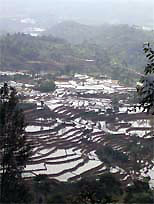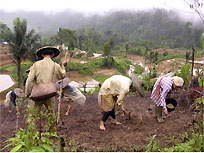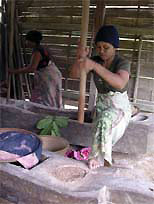(3) The administration of the Gunung Halimun-Salak National Park in West Java Province administratively overlaps with that of 103 villages. The national park contains a mix of different types of land use. These include primary forests, secondary forests, tea estates, rice fields, and croplands. Villagers in and around the national park engage in various kinds of
livelihood and farming systems. Some villages have experienced radical changes both in lifestyle and in farming systems, whereas others maintain traditional practices, following traditional customs and common law. In previous research, I found that farming systems and land-management practices influenced the composition and distribution of birds. This research was supposed to reveal the effects of temporal factors, such as changes in the season and in human activities, on birds at each research site.
The research was conducted in three sites adjacent to the Gunung Halimun-Salak National Park from December 2005 to April 2006. Since birds from other areas were on migration to this area, I focused on the migrating species that use the secondary environment at the research sites. In addition, I conducted interviews with villagers on their socio-economic conditions.
Recorded species of birds had declined at all sites. The reasons seemed to be the bad weather of the rainy season and changes in the habitat caused by human activity, such as the logging of fuel wood plantations, the conversion of large areas to intensive crop cultivation, and the reduction in low-cover vegetation because of livestock grazing. Migrating species utilized the secondary woodland at only one site.
The socio-economic survey revealed that differences in the size of arable area and in the kinds of crops were influenced by the forms of land ownership as well as by the limitations placed on farming systems by traditional customs.



 21st Century COE Program
-Aiming for COE of Integrated Area Studies-
21st Century COE Program
-Aiming for COE of Integrated Area Studies-